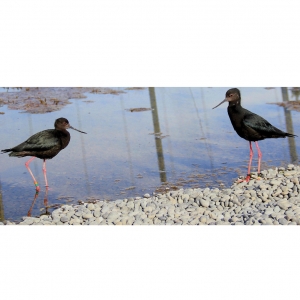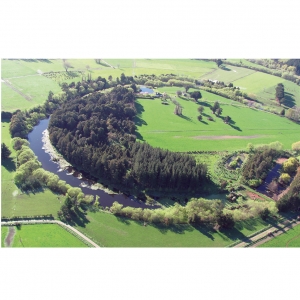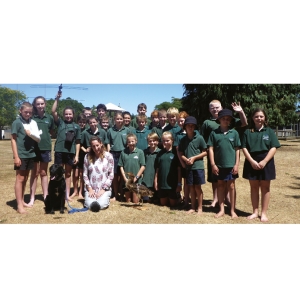Displaying items by tag: Wildlife
Pukaha Mount Bruce welcomes new General Manager
Pukaha has a new general manager, Emily Court. She started in her role immediately after Labour weekend.
Ms Court moved to the Wairarapa from Christchurch two years ago after spending the previous five years working in a business recovery role after the 2010 and 2011 Christchurch earthquakes. She led a recovery programme for the international education sector which included securing a $5million funding package during her tenure.
Emily has also had previous roles in banking, retail, economic development and international education. Her most recent role has been with the Wairarapa branch of Public Trust as a Professional Trustee and manager.
Ms Court has a business degree from Victoria University, an MBA and also holds a formal project management qualification.
This extensive business background will be a real asset to Pukaha, as they are in the process of planning several new and interesting developments.
Emily is excited about the new role and outside of it, will continue to spend time with her two children in their new Wairarapa home. In their spare time the family enjoys renovating their old bungalow in Carterton, riding their horses and exploring the North Island.
Welcome to the Pukaha team Emily
4/12
General Manager: Emily Court is now into her new GM position
Spring Has Sprung
The 2017/18 breeding season has begun and The Isaac Conservation and Wildlife Trust (ICWT) once again reached its busy rearing phase.
Early October saw the collection of the first clutch of critically endangered New Zealand shore plover eggs for artificial incubation. Critically endangered black stilt/kaki pairs had also begun laying eggs.
ICWT is happy to report that three clutches have been incubated by critically endangered orange-fronted parakeet breeding pairs, as well as eight healthy chicks presently being raised. (see page 9).
The first South Island blue duck/whio ducklings hatched, while North Island ducklings hatched soon after. Meanwhile five brown teal/pateke pairs have hatched ducklings and more will be on the way.
ICWT’s reptiles are becoming more active with the warming weather, meaning tuatara, Otago skinks and grand skinks will be breeding as well.
As always, ICWT’s ambitious native planting programme across the Isaac Conservation Park and the Otukaikino River restoration site continues; while salvaged historic buildings continue to be restored to their former glory in the Heritage Village.
For more information see:
http://www.isaacconservation.org.nz/
https://www.facebook.com/ICWTNZ/
Sabrina Luecht,
Wildlife Project Administrator,
ICWT
A unique New Zealand wetland enhancement project
In 2008 Taumata Lagoon, south east of Carterton in the Wairarapa Region of New Zealand, was classified as “A WETLAND OF NATIONAL IMPORTANCE”.
The lagoon is also recognised as the country’s best example of an “Oxbow Lagoon” – with both ends of the lagoon being only 300-metres apart.
In addition, the inner area of the lagoon contains between 200 and 250 ancient Totara and Kahikatea. (Possibly the most significant area of ancient forest on the floor of the Wairarapa valley).
The 34-hectare lagoon environment is also the home of over 40 different species of birds – including good numbers of the rare and endangered endemic NZ Dabchick, large numbers of NZ Shoveler, Grey Teal and Black Swan (there are now close to no mallards!), plus bush birds, including: Falcon, Kereru, Tui, Bellbird and huge numbers of Fantail.
In addition 110 different species of endemic plants have been identified in the area.
Taumata Lagoon
A wetland of national importance and a classic oxbox lagoon, with close to half of the lagoon and its environs being protected by a QEII National Trust Open Space Covenant.
The lagoon is 9 kilometres south east of Carterton – a rural town in the Wairarapa region of New Zealand.
Sylvia and Neil Hayes purchased part of Taumata Lagoon in 1990 and since then considerable enhancement of the environment has taken place, and, with lots of dedicated assistance, a weir to regulate water levels was constructed, well over 5000 willows have been removed, over 8000 Totara, Kahikatea and swamp flax have been planted and several thousand predators have been eliminated; with management of the predator control programme being carried out by the Greater Wellington Regional Council since 2000. The Timms trap was originally designed as a Possum trap, but has proven to be highly successful in the elimination of – feral cats, ferrets, stoats and hedgehogs. The largest ferret ever eliminated in New Zealand was in a Timms trap – at Tamata Lagoon.
Historically the most desirable lagoon water levels have relied heavily on flood water from the adjacent Waiohine River, but in 2014 a Waiohine River stop bank burst its banks – the result being that flood water pours through the gap and heads straight to the Ruamahanga River – instead of the lagoon!
The Waiohine and the Ruamahanga rivers converge three kilometres to the south of Taumata Lagoon and each river floods 3 to 4 times each year.
The Regional Council informed the four owners of Taumata Lagoon that they had no funds available to rebuild the stopbank – and the owner of the stopbank property said he didn’t want the stopbank rebuilt!
At my instigation, on September 14, 2016, a meeting was held on site to discuss how best the problem could be resolved. Involved were GWRC staff, the four lagoon owners, the Wairarapa QEII National Trust representative and the landowner of the stopbank area. With full support of all involved the outcome of the meeting was to reverse the flow of water through the adjacent neighbours flood drainage channel (which normally puts flood water back into the Waiohine River), construct a culvert under the road, construct a channel on the Hayes property and join it up with the culvert.
In 1942, in the same area, there were large numbers of endemic Totara (Podocarpus totara) and the endemic Kahikatea (Dacrycarpus dacrydioides), but all but seven of the Totara were milled during the 1950s.
This aerial photo was taken in 1942.
The area just above the gravel road at the bottom of the photo is where Suez #2 was created and where our final planting programme was completed in August 2017.
Many of the Totara and Kahikatea in the main part of the natural forest were also milled at the same time, but approximately 100 Totara and 250 Kahikatea survived and many of these have a QEII National Trust Open Space Covenant over them, which protects them and all plantings since 1990 in perpetuity. Most of the Totara and Kahikatea are ancient – with massive trucks!
Close to 50 different species of birds have been identified in the lagoon area and over 100 endemic trees and plants have
been identified.
The Hayes block of land where the “Suez #2” was created was leased to a neighbour for 10 years, but as soon as the lease expired Neil and Sylvia Hayes commenced another major native planting programme – initially with native swamp flax (for shelter belts) and then Totara.
Between 1990 and 2017 Neil and Sylvia have proven the ancient Greek proverb to be wrong: “THE WORLD GROWS BETTER WHEN OLD PEOPLE PLANT TREES KNOWING THAT THEY WILL NEVER SIT IN THEIR SHADE.”
All finished five days later – with grass seed spread throughout the flat ground. The flow of water from the neighbours drain was reversed – and instead of the water flowing back into the Waiohine River it now flows into Taumata Lagoon.
NZ Swamp Flax grows rapidly and provides an excellent wind break for other endemic plants and trees – and for the endemic Tui (Prosthemadera novaeseelandiae), Bellbird (Anthornis melanura) and the native Fantail (Rhipidura). The NZ Native flax provides an array of insects and nectar.
The first flow through the canal and into the lagoon was in April 2017.
Summary
A superb outcome to a complex wetland management problem.
Sincere thanks to the GWRCs Masterton Branch; the GWRC Head Office, all five landowners involved, particularly the adjacent neighbours – the Herrick Family – for their essential support with the use of their drain and the QEII National Trust for their support.
If further information is required please contact Neil Hayes on (06) 3796692 or by Email on This email address is being protected from spambots. You need JavaScript enabled to view it. – or at PO Box 188, CARTERTON.
Neil Hayes
QSM CEnv DU (NZ) Foundation Member & DU (NZ)
Life Member.
Tracker dog helps find and protect birds
Emma Williams and I are helping the South Wairarapa Schools - Martinborough, Pirinoa and Kahutara - to achieve some of their environmental studies assignments and general objectives.
Emma has visited Kahutara School once already and her talk was very successful, she had her dog Kimi with her and the children loved that.
Then Emma went up to Hawke’s Bay and further north where she worked with older young people. Emma has developed a package for schools on wetlands and wetland birds with bitterns in particular, and where they are in the habitat.
Emma’s lovely black labrador Kimi, helps with her work and accompanies her on visits to schools.
We will start another series of school visits in the South Wairarapa during August and plan to visit Wairio wetlands at some stage and track bitterns that have radio transmitters attached to them.
The overall plan is to introduce pupils to wetland conservation and so attract some new young members for Ducks Unlimited!
Gill Lundie




